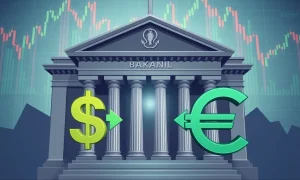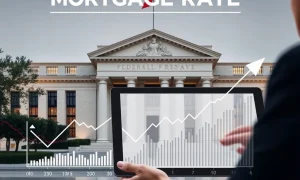President Donald Trump’s vocal demands for lower interest rates often sparked considerable confusion. Many observers wondered why he pushed so hard for a Trump rate cut. His outspoken criticism of the Federal Reserve’s policies generated significant debate. This stance challenged the traditional independence of the central bank. Understanding his motivations and Wall Street’s varied responses is crucial. This article delves into the intricate dynamics behind the push for lower rates. It explores the economic implications and the Fed’s steadfast position.
Understanding the Trump Rate Cut Push
President Trump consistently advocated for a Trump rate cut. He believed lower interest rates would provide a significant boost to the American economy. His public statements frequently criticized the Federal Reserve. He argued that the Fed’s rate hikes were hindering economic growth. This created a clear and unusual tension between the executive branch and the central bank. Trump often pointed to the strength of the U.S. dollar. He felt a stronger dollar made American exports more expensive globally. Consequently, this harmed domestic manufacturers and widened trade deficits. Lower rates, he argued, would weaken the dollar. This would make U.S. goods more competitive in international markets. Therefore, his economic team often supported this view.
Moreover, the President frequently highlighted global economic conditions. Other major economies, such as those in Europe and Japan, maintained very low or even negative interest rates. Trump believed the U.S. should match these policies. This would level the playing field for American businesses. His primary focus remained on sustaining robust economic expansion. He aimed to boost job creation and corporate profits. Especially leading up to re-election campaigns, strong economic performance was a key objective. A Trump rate cut was thus seen as a vital tool to achieve these goals. Furthermore, the ongoing trade disputes with China added another layer of complexity. Lower rates could potentially offset some negative impacts of tariffs. They would provide cheaper financing for businesses. This would help companies navigate increased trade uncertainties and costs. The President often emphasized the need for a competitive edge. He believed lower rates were essential for America’s economic dominance.
Wall Street’s Varied Views on a Trump Rate Cut
Wall Street’s reaction to discussions of a Trump rate cut was often complex. Initially, markets frequently rallied on the prospect of lower rates. Investors anticipated cheaper borrowing costs for corporations. This could fuel business expansion and boost stock prices. However, a deeper look reveals more nuanced perspectives. Many investors worried about the potential erosion of the Federal Reserve’s independence. This independence is widely considered a cornerstone of global financial stability. Political interference in monetary policy could lead to unpredictable outcomes. It might even destabilize the economy in the long run.
Different sectors held contrasting views regarding the impact. For example, commercial banks often face reduced profit margins. This happens when the difference between their lending and borrowing rates shrinks. Lower interest rates, therefore, could compress their net interest income. Conversely, growth-oriented technology companies often benefit significantly. Their future earnings are discounted at lower rates, increasing their present valuations. Similarly, dividend-paying stocks often become more attractive. Their yields appear more appealing compared to falling bond yields. Many analysts spoke of the “Powell Put.” This term suggested a widespread belief that the Federal Reserve would always act to support market stability. Thus, any significant market downturn would likely trigger rate cuts. This perception, whether accurate or not, heavily influenced investor behavior. It added another layer of complexity to the Trump rate cut debate. Fund managers carefully weighed these factors. They adjusted portfolios based on expected Fed actions and presidential rhetoric.
The Federal Reserve’s Mandate and the Trump Rate Cut Pressure
The Federal Reserve operates under a clear dual mandate. Its primary goals are achieving maximum employment and maintaining stable prices. This means keeping inflation low and predictable. Crucially, the Fed strives to remain independent from political influence. This independence allows it to make decisions based purely on economic data. It avoids short-term political cycles and electoral pressures. History demonstrates that political pressure on central banks can lead to poor policy choices. These choices often prioritize immediate gains over long-term economic stability.
Presidential administrations have historically attempted to influence the Fed. However, the intensity and public nature of Trump’s criticism were unprecedented. This challenged the long-standing tradition of central bank autonomy. Fed officials, including Chairman Jerome Powell, consistently emphasized their commitment. They stressed making data-driven decisions. They focused solely on their dual mandate. This steadfast position aimed to reassure markets. It also reaffirmed the institution’s independence. Balancing presidential demands with the Fed’s economic responsibilities proved immensely challenging. The institution had to navigate intense public scrutiny. It continued to make decisions it deemed best for the overall economy. The discussion around a Trump rate cut highlighted this fundamental tension. It underscored the critical importance of an independent central bank for sound economic policy. The Fed’s communication strategy became vital. They needed to convey their rationale clearly amidst the political noise.
Economic Implications of a Trump Rate Cut
A Trump rate cut, or any central bank rate reduction, carries significant economic implications. On one hand, lower borrowing costs stimulate economic activity across various sectors. Businesses can access cheaper loans for investment and expansion. This encourages capital expenditure and innovation. Consumers also benefit from lower mortgage rates and reduced credit card interest. This often boosts spending and overall demand within the economy. Consequently, this can lead to increased employment. It also supports higher asset prices, like stocks and real estate. The housing market, in particular, often experiences a significant boost. More affordable mortgages encourage home purchases and refinancing activity.
On the other hand, aggressive rate cuts pose potential inflation risks. If the economy is already operating near full capacity, excessive monetary easing can lead to overheating. This means demand outstrips supply, pushing prices higher across goods and services. Moreover, persistently low rates can inadvertently create asset bubbles. Investors might take on excessive risk in their search for higher returns. This could destabilize financial markets in the long run. The global impact of U.S. rate changes is also considerable. A weaker dollar, resulting from lower rates, affects international trade balances. It also influences global capital flows. Other central banks might feel compelled to adjust their own policies. This creates a ripple effect across the global financial system. Therefore, the decision to cut rates is always a delicate balancing act. It requires careful consideration of numerous economic indicators and potential side effects.
The interplay between presidential demands, central bank independence, and market expectations creates a complex economic landscape. The debate over a Trump rate cut highlighted fundamental questions about economic policy and governance. It underscored the delicate balance required for sustained prosperity. Ultimately, the Federal Reserve largely maintained its independent stance. It based its decisions on economic data and its dual mandate. This saga offered valuable insights into the dynamics of power and policy in a globalized economy. It showed how political rhetoric can shape, but not always dictate, monetary policy.
Frequently Asked Questions (FAQs)
Q1: Why did President Trump want a rate cut?
A1: President Trump believed lower interest rates would boost U.S. economic growth, weaken the dollar to help exports, and provide a competitive edge against other nations with low rates. He also saw them as a way to mitigate the impact of trade wars.
Q2: How did Wall Street react to the idea of a Trump rate cut?
A2: Wall Street’s reaction was mixed. Some investors welcomed the prospect of cheaper borrowing and higher asset prices. Others expressed concern over potential political interference with the Federal Reserve’s independence, which could destabilize markets in the long run.
Q3: What is the Federal Reserve’s dual mandate?
A3: The Federal Reserve’s dual mandate involves achieving maximum employment and maintaining stable prices. This means fostering an environment where most people who want jobs can find them, while keeping inflation low and predictable.
Q4: How does the Federal Reserve maintain its independence?
A4: The Federal Reserve maintains its independence by having its leadership appointed for fixed terms, by generating its own funding, and by making policy decisions based on economic data rather than political pressure. This ensures long-term economic stability.
Q5: What are the potential economic implications of interest rate cuts?
A5: Rate cuts can stimulate economic activity by lowering borrowing costs for businesses and consumers. This can boost investment, spending, and employment. However, aggressive cuts can also lead to inflation risks or asset bubbles if the economy overheats.








